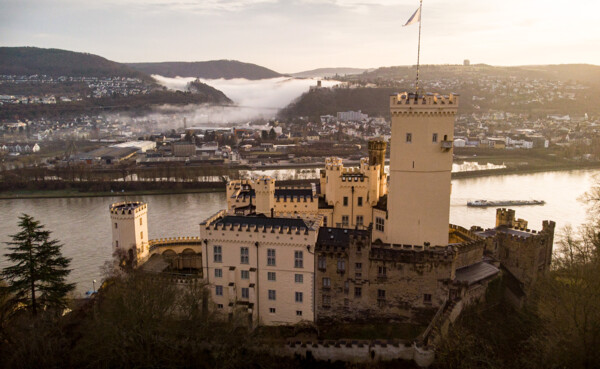Stolzenfels Castle (German: Schloss Stolzenfels) is a captivating architectural gem perched on the left bank of the Rhine River near Koblenz, Germany. Originally built as a medieval fortress, the castle was transformed into a Gothic Revival palace in the 19th century. Its storied past, architectural splendor, and breathtaking location make it a key landmark within the UNESCO World Heritage Site of the Upper Middle Rhine Valley.

A Medieval Fortress
The origins of Stolzenfels Castle date back to the 13th century when it was constructed as a defensive fortification by the Prince-Bishop of Trier, Arnold II von Isenburg. Completed in 1259, the castle was strategically positioned to protect the nearby toll station on the Rhine. During this period, the Rhine was a vital trade route, and the toll station was a significant source of revenue. Ships passing through were required to pay tolls, initially at Stolzenfels and later at Engers.
Over the centuries, the castle was expanded, particularly during the 14th century, to enhance its defenses. However, its strategic importance made it a target during various conflicts. During the Thirty Years’ War, it was occupied by French and Swedish troops, and in 1689, it was destroyed by the French during the Nine Years’ War. Following its destruction, the castle lay in ruins and was used as a quarry in the 18th century.

A Romantic Transformation
In 1802, the ruins of Stolzenfels Castle became the property of the city of Koblenz. It wasn’t until 1823, however, that the castle would begin its transformation into a palace. That year, the city gifted the ruined castle to Crown Prince Frederick William of Prussia, who later became King Frederick William IV.
The prince had traveled along the Rhine in 1815 and had been captivated by the beauty and romance of the region, which was becoming a focal point of the Romantic movement. Inspired by his cousin Frederick’s rebuilding of Rheinstein Castle and Maximilian II of Bavaria’s renovation of Hohenschwangau Castle, Frederick William set out to rebuild Stolzenfels as a Gothic Revival palace.

Architects Johann Claudius von Lassaulx, Karl Friedrich Schinkel, Friedrich August Stüler, and landscape designer Peter Joseph Lenné were among the prominent figures involved in the project. By 1842, the main buildings and gardens were completed, and the castle was inaugurated with a grand celebration, including a torchlight procession and medieval costumes. The Gothic chapel was inaugurated in 1845 during a visit by Queen Victoria, marking a significant milestone in the castle’s history.
Stolzenfels Castle became a summer residence for Frederick William IV and a symbol of the Romantic era’s fascination with medieval history and architecture. The interior work was completed by 1850, turning the castle into a regal retreat that blended historical reverence with 19th-century aesthetics.

A National Treasure
Following the First World War, Stolzenfels Castle became state-owned, and after the Second World War, it was assigned to the Landesamt für Denkmalpflege – Verwaltung der Staatlichen Schlösser. Today, it is managed by the General Directorate for Cultural Heritage Rhineland-Palatinate (Generaldirektion Kulturelles Erbe Rheinland-Pfalz).
In 2002, the castle’s historical and cultural significance was further recognized when it became part of the Upper Middle Rhine Valley UNESCO World Heritage Site. The site celebrates the region’s unique cultural landscape, with Stolzenfels Castle standing as a testament to the area’s rich history and architectural evolution.

Visiting Stolzenfels Castle
Stolzenfels Castle remains a popular destination for those exploring the Rhine Valley. Visitors can admire its Gothic Revival architecture, stroll through its meticulously designed gardens, and immerse themselves in the romance and history that define this extraordinary site. As a symbol of Prussian heritage and Romantic ideals, Stolzenfels Castle continues to captivate all who visit, offering a glimpse into both medieval and 19th-century Germany.


